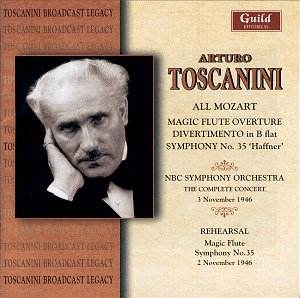A useful document here, with excellent annotations
by William H. Youngren. As is now to be expected with this series,
broadcast commentaries add to a sense of occasion. Zauberflöte
Overture is given a most invigorating reading. The repeated chords
are grandly stated, their Masonic status clear (the rest of the
introduction is most lovingly sculpted); the allegro positively
scampers along. It is the space between the two tempi that makes
the return of the chords all the more arresting.
The performance of the K287 Divertimento
is a real sign of the times. The solo violin part is played in
unison by a reduced first violin section, which must surely have
caused great alarm at the time amongst the orchestra members.
This performance as a whole is a strange mix. There are some miracles
of ensemble in the Adagio, but much else detracts. The opening
two chords may be attention grabbing, but for the wrong reason:
they are harsh and abrasive here. Toscanini drives the Allegro
hard. More elegance, even a touch of the suave, would not have
gone amiss.
The same problem attacks the Theme and Variations,
which certainly need to relax. The first violins sound as if they
are hanging on for dear life on occasion. Later, the Recitative
that opens the finale is jumpy and undignified. This is for Toscanini
die-hards only, I would suggest.
The Haffner’s first movement is remarkably
robust. There is a distinct feeling that Toscanini and his orchestra
are happier here, and certainly more confident. This is not to
imply that this reading is problem-free, however. The Minuet’s
Trio sounds like a second slow movement, with indulgent swells
aping expression. Still, the finale is fresh and bubbles over
with energy. The Maestro’s famous discipline is here, at last,
put fully to the service of the music.
Rehearsal sequences give us a window into the
machinations of the workings of this immortal relationship. They
remain an important historical document, but of course the gestures,
both of hand and eye, remain unseen so we are left with the famous
attempts at articulating ideas in heavily Italian-accented English.
It is hard going to work one’s way through 53 minutes of
Haffner once the novelty of being part of the atmosphere
has worn off. The vocal exchanges between Toscanini and his players
can be very distanced and one has to strain to catch the Maestro’s
drift.
Colin Clarke
see also review
by Paul Shoemaker
